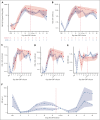A phase 1 clinical trial of NKTR-255 with CD19-22 CAR T-cell therapy for refractory B-cell acute lymphoblastic leukemia
- PMID: 38968138
- PMCID: PMC11522888
- DOI: 10.1182/blood.2024024952
A phase 1 clinical trial of NKTR-255 with CD19-22 CAR T-cell therapy for refractory B-cell acute lymphoblastic leukemia
Abstract
Although chimeric antigen receptor (CAR) T-cell (CAR-T) therapy has revolutionized the treatment of B-cell malignancies, many patients relapse and therefore strategies to improve antitumor immunity are needed. We previously designed a novel autologous bispecific CAR targeting CD19 and CD22 (CAR19-22), which was well tolerated and associated with high response rates but relapse was common. Interleukin-15 (IL15) induces proliferation of diverse immune cells and can augment lymphocyte trafficking. Here, we report the results of a phase 1 clinical trial of the first combination of a novel recombinant polymer-conjugated IL15 receptor agonist (NKTR-255), with CAR19-22, in adults with relapsed/refractory B-cell acute lymphoblastic leukemia. Eleven patients were enrolled, 9 of whom successfully received CAR19-22 followed by NKTR-255. There were no dose-limiting toxicities, with transient fever and myelosuppression as the most common possibly related toxicities. We observed favorable efficacy with 8 of 9 patients (89%) achieving measurable residual disease-negative remission. At 12 months, progression-free survival for NKTR-255 was double that of historical controls (67% vs 38%). We performed correlative analyses to investigate the effects of IL15 receptor agonism. Cytokine profiling showed significant increases in IL15 and the chemokines CXCL9 and CXCL10. The increase in chemokines was associated with decreases in absolute lymphocyte counts and CD8+ CAR T cells in the blood and 10-fold increases in cerebrospinal fluid CAR-T cells, suggesting lymphocyte trafficking to tissue. Combining NKTR-255 with CAR19-22 was safe, feasible, and associated with high rates of durable responses. This trial was registered at www.clinicaltrials.gov as #NCT03233854.
© 2024 American Society of Hematology. Published by Elsevier Inc. All rights are reserved, including those for text and data mining, AI training, and similar technologies.
Conflict of interest statement
Conflict-of-interest disclosure: D.M. reports consulting for Kite Pharma-Gilead, Juno Therapeutics-Celgene, Novartis, Janssen, and Pharmacyclics; and reports research support from Kite Pharma-Gilead, Allogene, Cargo Therapeutics, Pharmacyclics, Miltenyi Biotec, and Adaptive Biotechnologies. C.M. is a founder of, holds equity in, and consults for, CARGO Therapeutics, Link Cell Therapies, and GBM NewCo; holds equity in and consults for Ensoma and Red Tree Capital; consults for Immatics; receives research funding from Tune Therapeutics and Lyell Immunopharma; receives royalties from the National Institutes of Health and Stanford University for CD22-CAR; and holds multiple patents related to CAR-T therapies. S.S. reports research funding for Magenta Therapeutics, Bristol Myers Squibb, Allogene, Janssen, and Novartis; and reports consultancy to Magenta Therapeutics, Bristol Myers Squibb, Janssen, Sanofi, Oncopeptides, Takeda, Regeneron, AbbVie, and Pfizer. The remaining authors declare no competing financial interests.
Figures





Comment in
-
"Lymphorepletion" by IL-15.Blood. 2024 Oct 17;144(16):1650-1652. doi: 10.1182/blood.2024025793. Blood. 2024. PMID: 39418032 No abstract available.
References
-
- Majzner RG, Mackall CL. Tumor antigen escape from CAR T-cell therapy. Cancer Discov. 2018;8(10):1219–1226. - PubMed
-
- Ghorashian S, Lucchini G, Richardson R, et al. CD19/CD22 targeting with cotransduced CAR T cells to prevent antigen-negative relapse after CAR T-cell therapy for B-cell ALL. Blood. 2024;143(2):118–123. - PubMed
Publication types
MeSH terms
Substances
Associated data
Grants and funding
LinkOut - more resources
Full Text Sources
Medical
Research Materials

